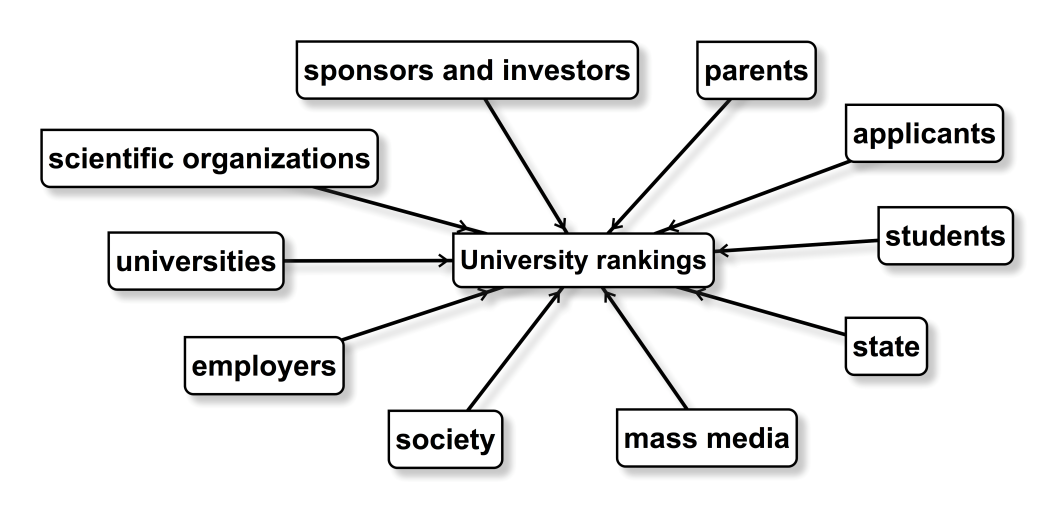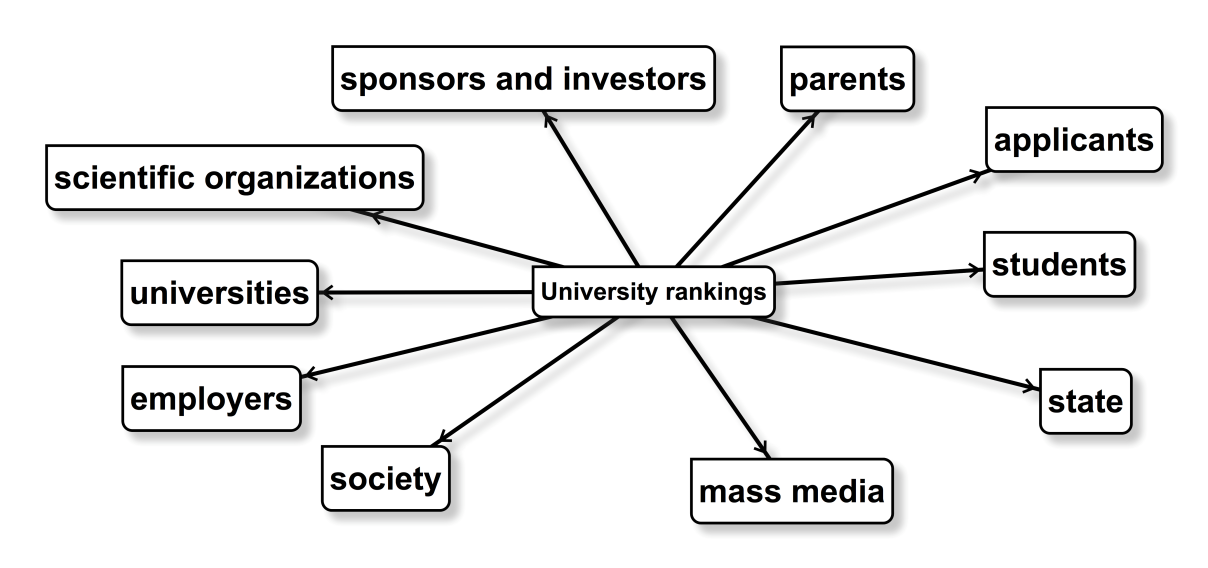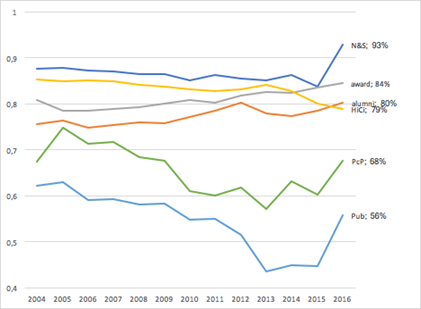Abstract
The quality of education attracts great attention in the post-industrial society. The processes of globalization contribute to the expansion of the educational space, ensuring the accessibility of quality education. In this regard, the competition of universities is one of the factors favouring the improvement of the quality of education. However, the ranking of universities is not only a source of statistics; it also acquires the role of an instrument for the development of the university itself. In the postmodern era it is important to take into account the more complex, "mediated" factors of many subjects which influence upon the educational space. The university ranking becomes the subject and object of the educational space; the authors of this article show that stakeholders - the actors of influence for the educational space - ensure the development of not only the educational institution (university), but also of the educational space in the long-term period.
Keywords: University rankingseducational environmenteducational spacesubject and objectactors of educational spacepost-industrial society
Introduction
Globalization has a significant impact on education, as well as the other social institutions. Nowadays there appear opportunities not only to study, but to choose a place of work or residence abroad. Accordingly, interaction and cooperation in many spheres of education necessitates expansion beyond the borders of a single country and the unification for the educational space. Bologna Agreements are a sort of an example for the creation of such a unified educational space. Implementation of these agreements provides students mobility, access to education in various educational organizations (universities) and improves the quality of education (Bebenina, 2011, 2016; EUMIDA, 2012; STRF, 2014; Expert RA, 20154 OECD, 2016). At the same time, these unification processes allow potential students, their parents and other stakeholders to compare universities; ultimately, it leads to competition among universities. This competition resolves in the form of creating universities rankings.
Problem Statement
The history of university rankings is relatively short. Many of them were created in the early 21st century. Let us consider the most popular modern university rankings: ARWU, THE and QS (Shanghairanking.com, Topuniversitites.com, Timeshighereducation.com). The first of them ranks universities, using available objective statistical data. The other two, the so-called reputation ratings, use expert opinions besides statistical data. To select these experts, there are certain procedures in each of the rankings; it allows stakeholders to be confident about the positions of universities in these ratings.
These rankings may include the same universities; however the same universities can have different positions there. Sometimes a university can be included in only one rating and not be represented in the other two. Among the reasons are the difference in the criteria that are included in the ratings, and the choice of experts, who rely on their personal opinion when assessing the activities of universities. But what can this “movement” of the university mean, that is, a change in its position within a single rating? Can this "movement" be used as a tool for improving the activities of the university itself, and more globally, to form an educational space in which the activities of the university take place?
Research Questions
The university's activity in the educational space has a significant impact on its position in a ranking. Let us consider, whether there is an “inverse connection”, or a kind of a feedback between a position of university in a ranking and educational space. What is the impact of university rankings on the educational space? At this stage, the study in a form of theses only indicates directions for further work on describing the phenomenon of university rankings as tools for influencing the formation of educational space in the near and distant future.
Purpose of the Study
The purpose of this study is to consider the university ranking as a subject and an object of the educational space.
Research Methods
We use qualitative and quantitative analysis, comparative analysis, theoretical experiment and modelling.
Findings
Actors of influence for the educational space
In the post-industrial society, the requirements to the quality of education are increasing, because the professions related to creative activity become more in demand. In this sense, the actors of the educational space are interested in the quality of education; they also have an impact on its development.
“We have attributed to actors of influence:
- legislative and executive bodies of state power and local self-government, in particular, educational management bodies at various levels;
- parents, public organizations, leisure centers;
- scientific and scientific-educational institutions (organizations);
- educational institutions engaged in training and retraining of personnel for the educational sphere (pedagogical training);
- labour market (employers of all levels, forms of ownership and activities);
- sponsors and investors;
- mass media;
- various institutions and phenomena of art and mass culture” (Ivanova, 2011).
Therefore, the universities rankings can be considered as a subject and an object of the educational space designing.
Ranking as an object.
“It does not matter if the interpretation is correct, but if people define situations as real, they are real in their consequences” (W. Thomas Theorem) (Merton, 1995).

The university ranking is an object of the educational space as well, because:
1. Universities form and expand the ranking with their data according to the stated methodology.
2. The questionnaires for the reputation rankings and citations database, prizes, etc., for the rest of the rankings, contribute to forming rankings.
3. Demand creates regional rankings or other rankings, for instance, rankings for specialities.
4. The methodology of rankings and objective and subjective data are studied by scientists, become subject to criticism and discussion (Ivanova, & Ivanov, 2016).
Ranking as a subject

The ranking may serve as a subject of educational space due to:
1. The very fact of having a ranking gives rise to curiosity, interest, which generates creation of rankings for previously unranked entities.
2. There is a demand for the universities with higher ranking positions on the part of applicants and science.
3. Criteria indicators influence university policies.
4. Ranking according to the country includes engaging into the state educational policy (for instance, Top-5 universities in Russia)
5. The compilation organization pursues its own goals (for instance, in connection with SCOPUS and Web of Science databases) and / or becomes a lobbyist for the other interests.
6. The ranking compiler becomes a brand and an expert in the market of educational services.
7. Points 1-4 in the process of implementation of activities generate a second wave of criteria and actions, not planned by the ranking creator explicitly. Examples include the phenomena that have become widespread in Russia and some CIS countries, i.e. the reduction in the number of universities through the merger of existing ones, the indicator of foreign students leads to the fact that students are admitted to universities with knowingly low level of preparation, however, they are the citizens of the other countries and they represent the indicator of foreign students, etc. (GARANT.ru, 2015).
In sociology, the “Matthew effect” is described: the phenomenon of uneven distribution of advantages, in which the party already possessing them continues to accumulate and multiply, while the other, initially limited, is deprived even more and, consequently, has fewer chances for further success (Robert Merton). From this point of view, increasing ranking position of the university (consequently, having more frequent reference in mass media) leads to an increase in its popularity, which attracts the attention of stakeholders.
“At present, the position of the university in international studies begins to affect the motivation of applicants and their parents. An analysis of the knowledge of applicants about the entry of the Nizhegorodskiy State University in the TOP-601 + World ranking of universities QS World University Rankings shows: they do not just know ..., but this has affected the choice of the university in 24.2% of respondents (10.1% higher compared with the survey last year) (the survey was held in 2012 and 2011 respectively)” (Efimova, 2013)
Practice shows that the inflow of applicants entering the university may lead to overall increase of money supply of the university; high competition may attract more excellent students; as a result the use of extended educational programmes and better financing will lead to the complex and interrelated improvement of all indicators of the quality of the educational process (Ivanova, Elkina, 2016).
What is an effect of the growth of reputation indices? Let us have an example. ARWU ranking practically does not depend on the reputation indicators; from the other two, QS and THE, let us choose that one which has openly accessed data during a long period of time. This is THE ranking, which has existed since 2011. In 2011 in included 200 universities. We consider the university which is placed somewhere in the middle of the list. In 2011 the École Normale Supérieure de Lyon occupied the 100th place.
Let us look at the indices of ENS de Lyon in THE (Timeshighereducation.com).
What about the other universities which occupied the 100th place in THE in various years?
Only in 2011 and 2012 there was one university at the 100th place; in 2013 there were three universities at the 99th – 101st places. However, Humbolt Universitat, Berlin, did not give the full data, that is why it is excluded from our further research. The other universities are represented in the tables.
All the universities demonstrate different strategies of reaching Top-199, we can only note that the high index “Industry income” is not accompanied by the high index “Research” and vice versa. “International outlook” seems to grow while “teaching” is more likely to decrease.
However, the role of quoting is invariably high (in accordance with the Effect of Matthew).
Let us look at the 100th place of the ARWU ranking.
In 2003 there were three universities at the 100th place; therefore we confine ourselves to describing criteria.
In 2003 ranking methodology included the indices “Nobel prize winners” and “Faculty” and did not include “Alumni”, “Award” and “PCP”.
We can note that the American universities have higher rates connected with their publishing activity. Let us see if it is a general pattern or an accidental peculiarity of the universities which occupied the 100th place. For this purpose we tale one of three indices, related to quotation – “N&S” and define the mean grade for the Top-100 universities according to the countries. This result is given in Table
It is seen that there are peculiarities in national policies of different countries: there are countries with traditionally low rate of publications in the journals “Nature” and “Science”; there are countries with traditionally high rate of such publications and there is a certain number of countries which seriously changed their publication index during last 13 years. China increased from 10.8 in 2013 to 28.5 in 2016; Denmark from 19.7 in 2003 to 30.9 in 2016 (Rauhvargers, 2013; Thomson Reuters, 2017). At the same time the publication activity index is the most correlated index with the total grade, and this correlation grows (Table
The same information can be visualized at the diagram (Figure

Therefore, the editorial policy of the journals included to the international database “Web of Science” (for example, “Nature”) plays an important role in the ARWU ranking, and its change leads to the change of universities’ rankings. However, China provides the state support for publication activity, which leads to the increasing of publication grades and allows two Chinese universities to be included into the Top-100.
Conclusion
Solely statistical indicators demonstrate the past of the university, its already accomplished achievements. They relate to the university history, although this history influences the current position of the university in an objective rating. The high ranking position attracts applicants and their parents when they choose the university, however, the professional growth and career of the graduate does not depend on the statistics of the university.
Modern complex ratings with flexible reputational criteria determine the zone of proximal development for the university itself. The ratings, which are compiled with the expert reviews, take into account the immediate prospects for the development of this particular university in accordance with the currently existing social, cultural, economic and political conditions.
Postmodernism takes into account the more complex, "mediated" factors of many subjects that affect the educational space. The ranking that includes the opinions of the actors of the educational space sets the parameters for the development of this educational space in the distant future.
The work was carried out within the State Assignment of the Institute for Strategy of Education Development of the Russian Academy of Education for 2017-2019 “Methodological support of interdisciplinary research in the field of education (No. 27.8520.2017 / BCh)”.
References
- Bebenina, E.V. (2011) Obshchestvenno-professional'naya ekspertiza kachestva obrazovatel'nogo protsessa kak osnova dlya prinyatiya upravlencheskikh reshenii. Tsennosti i smysly. 6. P. 85-107 [in Rus.]
- Bebenina, E.V. (2016) Rankings in education: history and critical analysis of rates. SHS Web of Conferences. Vol. 29. 01006. DOI:
- Efimova, I.N. (2013) Universitetskije reytingi kak instrumenty reformirivanija sistemy vysshego obrazovanija v globalnom kontekste. Alma mater (Vestnik vyshey shkoly), 9, P 12 [in Rus.]
- EUMIDA, (2012) Feasibility study for creating a European university data collection. Final study report, 2012. Available at URL: http://ec.europa.eu/research/era/docs/en/eumida-final-report.pdf (Date of access 02.03.2014).
- Ivanova, S.V. (2011). O sozdanii blagopriyatnoi vneshnei sredy uchrezhdeniya professional'nogo obrazovaniya: aktory, pozitsii, usloviya. Sbornik materialov V mezhdunarodnoi nauchnoi konferentsii. Tom 1, str.102-112 “Metodologicheskie voprosy nepreryvnogo professional'nogo obrazovaniya v usloviyakh informatsionnogo obshchestva”. Kiev [in Rus.]
- Ivanova, S.V., Elkina I.M. (2016) Postmodernizm i kachestvo obrazovaniya (postanovka problemy). Tsennosti i smysly. Vol. 1. 6 (46). P. 115-124. [in Rus.]
- Ivanova, S.V., Ivanov O.B. Society demands for the quality of education as a factor of modern education space forming. SHS Web of Conferences. 2016. Vol. 29. 01028. DOI:
- Materials of rating agency "Expert RA". Retrieved from: URL http://raexpert.ru/ratings/history (Date of access: 17.04.2015)
- Materials of the portal GARANT. Retrieved from: URL http://base.garant.ru/70291362/1/#block_1000#ixzz3fdXTQWte (Date of access: 17.04.2015)
- Materials of the portal STRF. Retrieved from: URL http://www.strf.ru/material.aspx?CatalogId=221&d_no=38618#.U28aTvl_tFs (Date of access: 22.09.2014)
- Materials of the web-site Shanghairanking. Retrieved from: URL http://www.shanghairanking.com/ARWUMethodology-2015.html (Date of access: 22.05.2015).
- Materials of the web-site Topuniversitites.com. Retrieved from: URL https://www.topuniversities.com/university-rankings (Date of access: 27.02.2017).
- Materials of the web-site Timeshighereducation.com. Retrieved from: URL https://www.timeshighereducation.com/world-university-rankings (Date of access 01.02.2017).
- Merton, R. (1995) The Thomas Theorem and the Matthew Effect. Social Forces, 74 (2). Retrieved from: http://garfield.library.upenn.edu/merton/thomastheorem.pdf.
- OECD, Assessment of Higher Education Learning Outcomes. Feasibility Study Report. Volume 2 – Data Analysis and National Experiences. Retrieved from: URL http://www.oecd.org/edu/skills-beyond-school/AHELOFSReportVolume2.pdf (Date of access 11.03.2017).
- Rauhvargers, A. (2013) Global university rankings and their impact. Report II. EUA report on rankings 2013. Retrieved from: URL http://www.eua.be/Libraries/publications-homepage-list/EUA_Global_University_Rankings_and_Their_Impact_-_Report_II (Date of access 03.03.2017).
- Thomson Reuters, Global Institutional Profiles Project. Retrieved from: URL http://ip-science.thomsonreuters.com/globalprofilesproject/ (Date of access 13.05.2017).
Copyright information

This work is licensed under a Creative Commons Attribution-NonCommercial-NoDerivatives 4.0 International License.
About this article
Publication Date
21 August 2017
Article Doi
eBook ISBN
978-1-80296-027-3
Publisher
Future Academy
Volume
28
Print ISBN (optional)
-
Edition Number
1st Edition
Pages
1-599
Subjects
Education, educational equipment, educational technology, computer-aided learning (CAL), study skills, learning skills, ICT
Cite this article as:
Bebenina, E. V., & Elkina, I. M. (2017). University Rankings As A Subject And An Object Of Educational Space. In S. K. Lo (Ed.), Education Environment for the Information Age, vol 28. European Proceedings of Social and Behavioural Sciences (pp. 150-160). Future Academy. https://doi.org/10.15405/epsbs.2017.08.19

